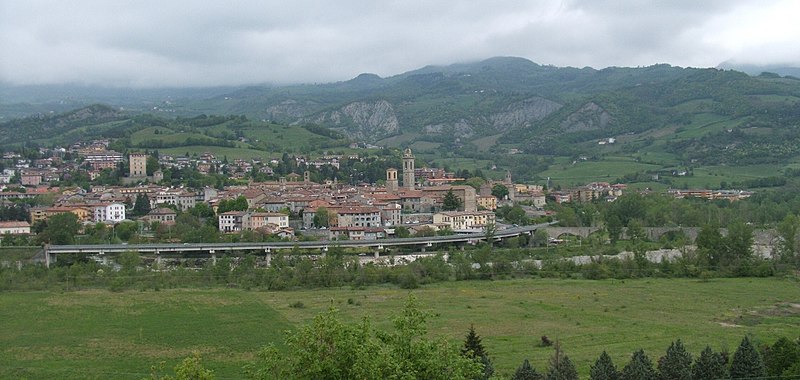Misyon Online - November-December 2011
Angie Escarsa is a Columban Lay Missionary from the Diocese of Iba, Zambales, and is assigned to Ireland.
COMMENTS
See more Misyon Videos
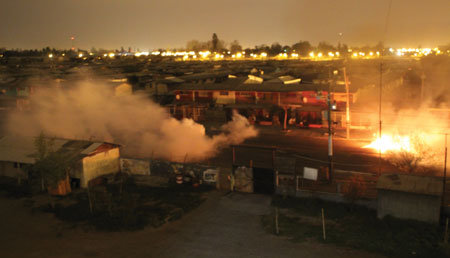
Columban priest John Boles defends his church during September disturbances in Chile.
One Step Forward, Two Steps Back
By Fr G. Chris Saenz
Father Saenz, ordained in 2000, is from Omaha, Nebraska, USA, where the Columban headquarters in that country are located. He spent part of his formation period in the Philippines.
I’ve learned that mission is one step forward and two steps back. This insight hit me on the night of 11 September in our Columban Parish of Santo Tomás Apóstol in La Pintana, an area in the southern part of Santiago de Chile. At 2am I received a frantic call from our parish coordinator, Elizabeth, screaming and crying, ‘Father!
Night at the Riots
Fr John Boles is from England and is currently Rector of Student Formation and Parish Priest of Santo Tomás Parish in Santiago, Chile. He belongs to the Columban Region of Peru.Fr Chris Saenz describes in this issue the 2011 riot in La Pintana. Here Fr Boles describes last year’s.
Ever think you might get tear-gassed? Here are a few survival tips: Have a wet handkerchief or surgical mask handy, to cover your nose and mouth; smear a little toothpaste under your eyes - it helps; don’t rub your eyes after being gassed, it’s better to let them stream; once you’ve reached safety, suck a lemon.
Celebrating Christ in the Mountains of Ifugao
Fr Gil Rochar Pancho-Dulay, SVD
The author, an SVD priest ordained in December 2008, is from Baybay, Bulan Sorsogon. He is currently parish priest of Our Lady of the Assumption Parish, Salegseg, Balbalan, Kalinga, and director of St Theresita’s School there. Here he tells of his experience when he was assigned to the Mountain Province.
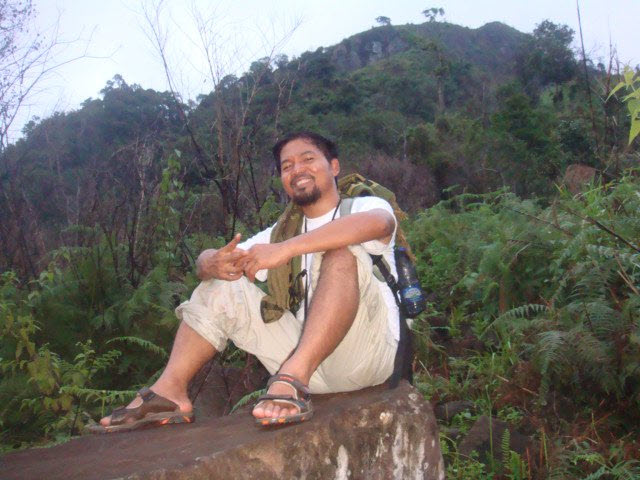
The thought of the Cordilleras haunted me through my childhood and seminary days, even though one of my motives for joining the Divine Word Missionaries (SVD) was to be assigned to a foreign mission. Before ordination we were asked to write our preferred countries of assignment. I wrote Mexico as my first choice, China as my second and lastly, the Philippines. I hadn’t specified any of the three SVD provinces in the Philippines but our prefect insisted I do so, in case my other first two choices would not materialize. Mesmerized and enchanted by the beauty and culture of the Cordilleras, I immediately wrote ‘Northern Province’. It’s the place that captivated my adventurous spirit one summer when I was assigned to Calanasan, Apayao.
Hope for Midsalip
By Mary Joy Rile
There can be no peace without equitable development; and there can be no development without sustainable management of the environment in a democratic and peaceful space. This shift is an idea whose time has come.
~ Wangari Maathai ~
Mindanao, Ang Yutang Gisaad, ‘The Land of Promise’ to its people. The many stories I grew up with – of the diverse natural beauty, the multi-cultural nature, the many stories of struggles, frustrations, hopes and successes – in that part of the country fed my curious mind and a longtime dream of landing on Mindanao soil. That dream was granted when Anne Gubuan, our assistant editor, and I reached Ozamiz City on 24 June, our first stop. We were to visit different areas where Columbans are present. And on 27 June I went to Midsalip, Zamboanga del Sur.
The Lord of the Manger
Fr Vincent Busch
For the past ten years I have been working in a livelihood project with a group of Subanen artisans. Every year we design Christmas cards that simultaneously celebrate the story of God’s Creation and the story of God’s Incarnation. This year the Subanen artisans are carefully crafting images of Jesus in the manger within five ever-expanding settings from the tiny stable in Bethlehem to the vast heart of our spiraling Galaxy. While they craft cards, I have the task of crafting a reflection – with a lot of help from St Francis – about the meaning of their cards.
St Francis is credited with instituting the Christmas custom of setting up manger scenes in our homes and churches. The story goes that shortly before Christmas 1223 Francis encouraged the people of Greccio to reconstruct a manger scene in a cave near their town. He explained to the people: ‘If you want to celebrate the Feast of the Lord at Greccio, hurry and diligently prepare what I tell you. For I wish to recall to memory the little child who was born in Bethlehem. I want to set before our bodily eyes the hardship of his infant needs’. The manger scene touched the hearts of the people of Greccio and it continues to touch our hearts today.
Immigrant Spouses Journeying Towards Employment
Necita or Cita, originally from Tubod, Lanao del Norte, Philippines, has a degree in Psychology. She joined the Columban Lay Mission orientation program in 2001. During her first and second mission terms in Korea she worked with the urban poor, based in a mission parish in Seoul. She facilitated liturgies and visited the elderly. She taught English to poor children and was also involved in Catholic scouting, which assists youth programs in the parish and in schools. After her sixth year as a Columban lay missionary she began to minister to multi-cultural families in Ganghwa Island. She writes about that here.
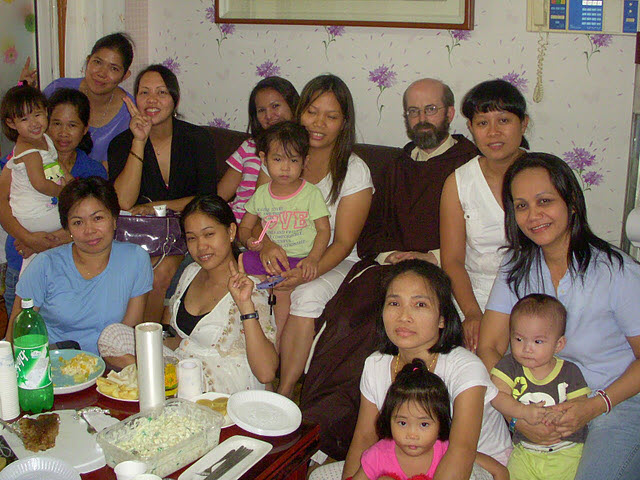
Cita (far right) and Fr Laurence Kettle OFMCap with some Filipino women married to Koreans.
Cita is now home for good after nine years of mission work in Korea. She left the Columban Lay Missionaries to look after her aging and ailing parents. Her father was paralyzed by a stroke 20 years ago and his condition deteriorated last year. Her mother is suffering from diabetes and is scheduled for an eye operation soon.
Providence and Google
By Fr Charles Duster
Fr Duster, from the USA, has worked in Japan and Fiji. During a visit to the Philippines in 1967 he and another Columban were to have traveled on a flight from Bacolod to Cebu on 6 July. Although slightly delayed because they had visited another Columban in hospital, they were still on time for checking in but they weren't allowed on board. The plane left early and crashed all 21 on board being killed.
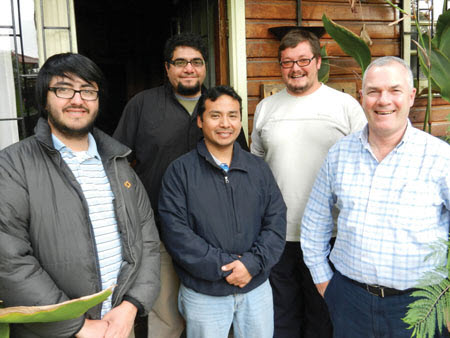
L to R: Rafael, John, Jorge, Gonzalo, Fr John Boles.
The ways of Providence are unusual and wonderful.
It started with a simple question over the dinner table at the Columban House on the north side of Chicago, ‘Rafa, what was your first contact with the Columban Fathers?’
Rafael (Rafa) Ramirez is a Columban seminarian from Chile who was completing a ten-month English language study program at De Paul University and returned to Chile in January 2010. He is continuing his theological studies at Catholic University, Santiago, in preparation for his first missionary assignment next year as a Columban missionary.
‘PLANTED AND BUILT UP IN JESUS CHRIST, FIRM IN THE FAITH’ (cf Col 2:7)
By Sr Ashwena Apao SSC
Sister Ashwena is a Columban Sister from Jimenez, Misamis Occidental, which has one of the oldest Spanish churches in Mindanao and was a Columban parish for many years. She gets her name from the fact that she was born on Ash Wednesday. Sister Ashwena is based in Myitkyina, northern Myanmar.
This was the theme of World Youth Day (WYD) 2011, held recently in Madrid, Spain, in which 1.2 million persons participated. WYD was a time when young and not so young people from all over the world gathered together to pray and share experiences coming from within the cultural richness of each one. Everybody went with their own agenda, searching for truth, longing for a deeper meaning in their lives. Everybody wanted to encounter the truth of Jesus Christ, which they believed would set them free.
Pulong ng Editor
Celebrating Christ In The Mountains Of Ifugao
Fr Gil Rochar Pancho-Dulay, SVD
The author, an SVD priest ordained in December 2008, is from Baybay, Bulan Sorsogon. He is currently parish priest of Our Lady of the Assumption Parish, Salegseg, Balbalan, Kalinga, and director of St Theresita’s School there. Here he tells of his experience when he was assigned to the Mountain Province.
The thought of the Cordilleras haunted me through my childhood and seminary days, even though one of my motives for joining the Divine Word Missionaries (SVD) was to be assigned to a foreign mission. Before ordination we were asked to write our preferred countries of assignment. I wrote Mexico as my first choice, China as my second and lastly, the Philippines. I hadn’t specified any of the three SVD provinces in the Philippines but our prefect insisted I do so, in case my other first two choices would not materialize. Mesmerized and enchanted by the beauty and culture of the Cordilleras, I immediately wrote ‘Northern Province’. It’s the place that captivated my adventurous spirit one summer when I was assigned to Calanasan, Apayao.

At first I was dismayed by the result of my application because neither of my first two choices were approved. I accepted that maybe the Lord wanted me to be rooted first and learn about my identity as a Filipino before being sent outside. After ordination to the priesthood, I was sent to Claveria, Cagayan, for more than a month to learn how to say Mass in Ilocano. I had been told that I would be assigned to Sadsadan, Bauko, Mountain Province, in the Apostolic Vicariate of Bontoc-Lagawe, as assistant priest to Fr Bong Garay, SVD. I arrived there in July 2009.
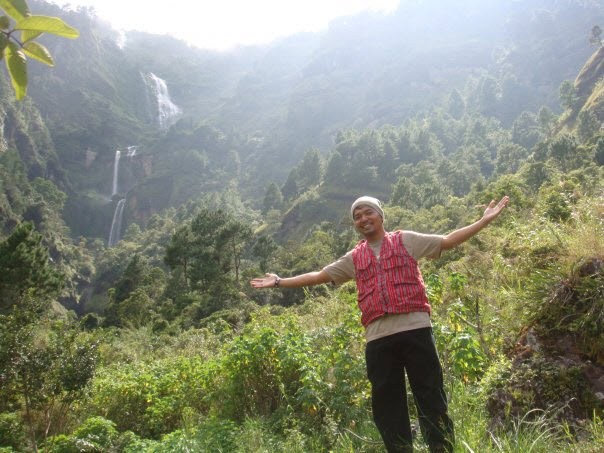
I enjoyed my stay with the Kankanaey people, learning and appreciating their culture. I once said to them in my homily during the Indigenous People's Sunday, ‘Be proud of being an Igorot, be proud of being a Kankanaey . . . your culture is God's greatest gift to you and to the Philippines as well. I am very fortunate that I was able to see, feel and live the very life of our forefathers, of which the Spanish Conquerors had deprived us ‘lowlanders’ due to the massive Christianization that brought havoc to our primitive culture.’ Though I stayed there for fewer than nine months, I was really thankful to the people because they had taught me how to appreciate more my being a Filipino by being rooted in my culture. It boosted my missionary spirit to reach out and learn the diverse culture of the Cordillera people, seeing it as God's greatest gift to us.
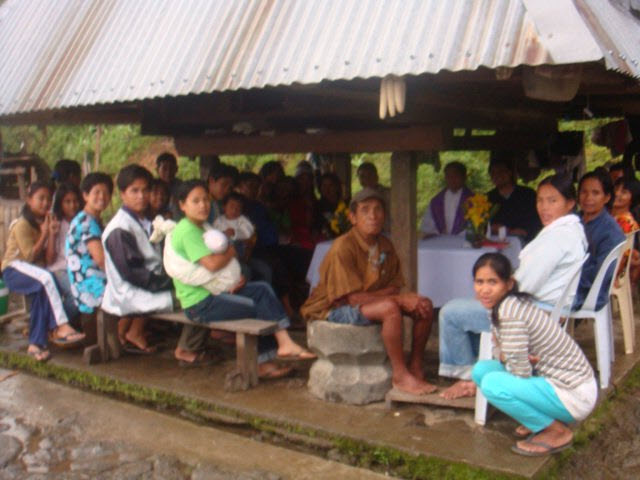
I was sent to the Our Lady of Assumption Mission Station, Mayoyao, Ifugao, to replace Fr Romeo Benitez who had been transferred to Claveria, Cagayan. The Mayoyao Catholic Mission was established by the CICM Fathers more than 60 years ago. It is now under the administration of the Divine Word Missionaries and is comprised of 16 Basic Ecclesial Communities (BECs) and includes Assumption Academy. I try my best every month to visit all BECs for Masses, baptisms, weddings and the other sacraments. I also invite resource persons to give seminars, recollections and spiritual talks that would deepen the faith of the people.
Though all 16 BECs are dear to me, that of Inwaloy is the most special. It is the newest, composed of new converts from the Espiritistas, one of the earliest Christian sects in the Cordilleras, and Catholics from other parts of the Cordilleras who intermarried with the Ifugao people and stayed. I see to it also that I visit them outside my usual schedule to give catechesis about the Catholic Faith.
After Mass we usually share a meal prepared by the people, with pan de sal, barako coffee, organic rice of different varieties and colors, and pinikpikan native chicken. This is a time for entertaining their questions on the Catholic faith. They ask about devotion to Mary and the saints, the existence of purgatory and other topics.
Every time I go to Inwaloy, I hike with two or three companions from the poblacion. We take a 15 to 20-minute ride to Bolhe, then walk for about an hour and a half. Inwaloy is five or six kilometers from the highway. The road that we usually take is being widened. But due to the lack of budget, only two kilometers from Bolhe has been completed. Due to constant rain causing landslides and erosion, that two km stretch has been damaged. We have to pass through cliffs, climbing up and down terrain that is uneven, partly because of soil erosion caused by too much degradation of the place due to the 'kaingin system.' Hiking is challenging for me. However, hidden between the forested areas of Inwaloy is the enchanting Tenogtog Waterfalls, dropping from a height of 50 feet or more cascading through the fertile land of Inwaloy. Water is life for the people, not only for drinking, but all the more because the falls irrigates their centuries-old rice terraces.
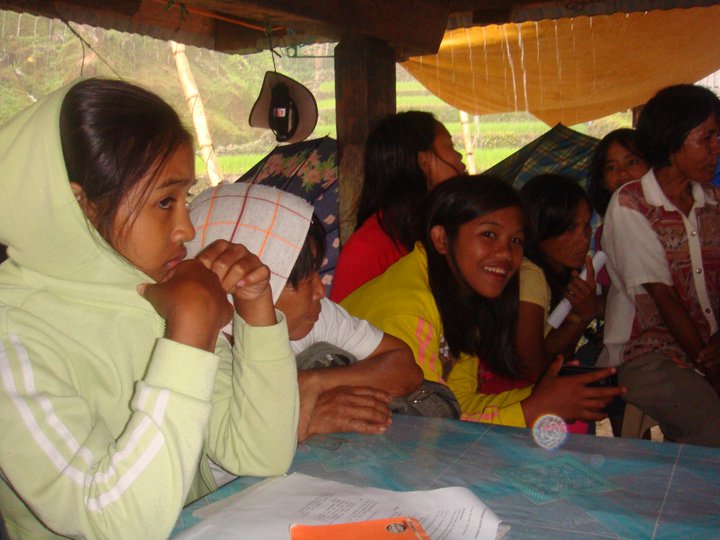
During one of my earliest visits to Inwaloy, we started Mass in fair weather when suddenly the rain poured down heavily. The wind blew so hard that we had to use the blackboard to shield us from. We also had to squeeze ourselves into a small native house. We formed a circle around the altar and continued with the Mass. The rain gave me something to ponder for my homily and I said: ‘This is a blessing for each of us. With this rain, it is good that we become closer to each other physically instead of being divided. Just like in times of crisis, this is also the best time for us to become closer to God. When we are in crisis, the more we remember Christ. And at this very moment, the more we come closer to Christ, the more we become closer to each other.’ The ceiling of hut is very low so we had to sit down during Mass. What struck me most was the opportunity that made us closer to each other.
After this Mass I had to hike for two and a half hours for another Mass, with the BEC in Maga-Magulon. I had to pass through rivers and mountain ranges with majestic and enchanting rice terraces before reaching the Chapel of St Luke at the foot of Mt Amuyao, one of the highest peaks in the Cordilleras.
The Catholic Church in Inwaloy is also experiencing persecution and harassment ever since some of the people there started converting to Catholicism. For one, the Espiritistas were angry, thinking that their members were being proselytized. The fact is that some, when they go to study in Ifugao State Univeristy (IFSU), and Catholic Universities such as St Louis University (SLU) in Baguio, get to learn, know and appreciate more the Catholic Faith.
Relations between Espiritistas and Catholics are now better. I once gave the sacrament of the sick to a daughter of a medium of the Espiritista, who was converted to the Catholic faith when she married a Catholic in the Catholic Church. Unfortunately she died a month after the wedding. I celebrated Mass at her wake with the permission of her family in their house beside the chapel of the Espiritistas.
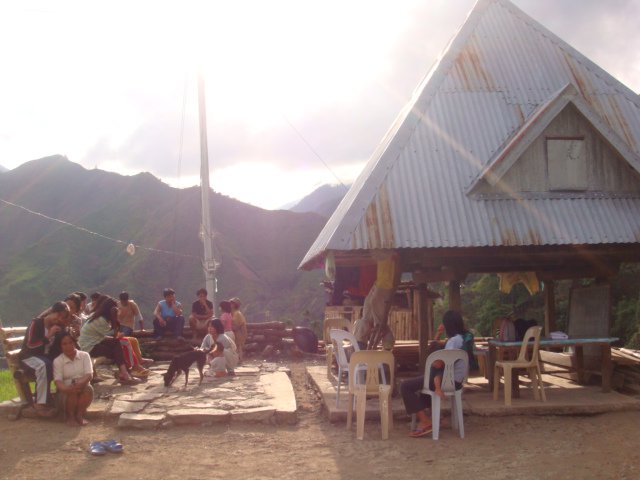
The people of Inwaloy look forward to the monthly Masses. I try to visit them twice a month and join them in their seminars if time permits. They are truly grateful for the Catholic services granted to them. Given the difficulty of gathering in their place, they wish to have a chapel where we can hold Masses, BEC seminars and other church activities. They are very willing to help but don’t have the means to buy the materials needed.
In every Mass, in every encounter, it is Christ whom we celebrate. The miracle happens every time, even to those who do not believe. The grace of a generous God continues to flow to His people through His instruments of love.
May God continue to grant you blessings. Dios Mabalos po!
You may email Father Gil at gilrochar75@yahoo.com.ph
Hope For Midsalip
By Mary Joy Rile
There can be no peace without equitable development; and there can be no development without sustainable management of the environment in a democratic and peaceful space. This shift is an idea whose time has come. ~ Wangari Maathai ~
Mindanao, Ang Yutang Gisaad, ‘The Land of Promise’ to its people. The many stories I grew up with – of the diverse natural beauty, the multi-cultural nature, the many stories of struggles, frustrations, hopes and successes – in that part of the country fed my curious mind and a longtime dream of landing on Mindanao soil. That dream was granted when Anne Gubuan, our assistant editor, and I reached Ozamiz City on 24 June, our first stop. We were to visit different areas where Columbans are present. And on 27 June I went to Midsalip, Zamboanga del Sur.

The claim for ancestral domain is the longtime plight of the Lumads. Many parts of Mindanao are being used up by outsiders and foreigners leaving the Lumads landless or running after the land which was supposed to be theirs. Midsalip in particular is just one part of the ‘promised land.’
I remember the article The Heart that Pumps Water which we featured in Misyon in May-June 2010 with Pat McCarthy writing about the Mt Pinukis ranges, through which I first learned the reality in Midsalip. Going there, I was hopeful to see improvements after a year. But to my surprise, what I discovered was truly heartbreaking.
Reaching Balay Bityalan Nu Ngak Subanen, the apostolic center of the Columban Sisters, I and my companion Virgie Oral were taken by motorcycle to the mining picket area. I met only a few people as we had to rush back after only ten minutes because of rain. The three of us got really wet. Imagine the difficulty of riding a motorcycle, of which I am not fond, holding an umbrella at one hand and keeping balance as we rode through the rain down the bumpy road, though I must admit that I somehow enjoyed that extraordinary moment, considering the rain a blessing from the heavens. Our consolation was that what we were experiencing was nothing compared to the many struggles of the Subanens.
Balay Bityalan Nu Ngak Subanen
Back to the center, we were humbled by the presence of the Subanens and some of the accused Fr Sean Martin wrote about in When It Rains It Pours! A criminal case was filed in the Regional Trial Court of Aurora against nine people including himself and Peruvian Columban Sister Patty Adonaire in October 2010, on the grounds of obstruction of the operation of drilling machine for mining. A civil case was also filed against them in December 2010. A temporary restraining order (TRO) was then released by the judge in favor of the mining companies simply on the basis of the accrued rental charges of the drilling machine. The picketers trying to protect their land were harassed but witnesses denied this. The witnesses, from among the Subanens, were bribed in favor of the mining companies. Subanens, the inhabitants of Midsalip are restrained from walking on their land. ‘The people who are taking care of the land, for irrigation and for food, have now become land criminals,’ uttered Columban Sr Kathleen Melia in disappointment.
Midsalip picket area
The defendants expressed their frustration at the judge’s decisions. When they filed a motion for lack of evidence, there was no action since June. Now, a full injunction is filed against them which could lead to imprisonment.
I asked the defendants how they deal with the case knowing that they have families and other concerns. They expressed that thinking of the situation is causing them confusion and is really depressing. People are worried about their case. But they don’t tell their families everything about the real situation as they don’t want them to worry much.
At that time of my visit, they had already attended 13 hearings in Aurora, usually scheduled at 2:00 PM. Every trip cost them around P3,000.00. Their resources and energy were exhausted.
They believe that what the companies are doing is a clear violation of RA 8371, the Indigenous People’s Rights Act. The Subanens have the right to hold their land and their consent is needed for any activity in it. The certificate for exploration that the mining companies are holding was signed by bribed individuals, not by the real tribal leaders. No consensus was sought. It seemed to be manipulated.
Sr Kathleen shared her views of the situation: ‘If a Subanen cuts down one tree, he is charged for breaking the law. But what about the loggers who move freely? The Subanens have been oppressed in their own land. When mining is permitted, the companies will claim the land, the water, the trees and the rest. There is no justice here in Midsalip.’ Mining is not in the culture of the Subanens but the local government is pro-mining. The exploration began during the previous administration.
The Philippines tends to pattern mining activity on that of other countries in the name of economic development. The big difference is that in other countries it does not pose a high risk to the environment and the people unlike here in the Philippines where we have active volcanoes and geological faults. Mt Pinukis of Midsalip, for example, is the main source for the water system of the three provinces of the Zamboanga peninsula and is a reforested area.
Pagmina o Kasiguroan sa Pagkaon ug Kaugmaon
Message from the Subanens
When I asked some Subanens what message they would like to convey to the public this is what they had to say.
- Let us help in protecting the mountains because this is for the good of everyone.
- The country has a big budget for reforestation but it’s useless since the lands are set aside for mining.
- People should unite to preserve Mother Earth. Man shall perish but Mother Earth will remain.
- The National Commission for Indigenous Peoples (NCIP) tends to view things from a business perspective. They are pro-development when they should be pro-IP.
- Mining is pro-aggression. We call for the government to weigh mining and income.
- The land should be protected and cared for because life lies in it. No mining favors ancestral domains.
- The present administration has not yet issued a ban on mining. It only refers to Republic Act 7942. The court sees the destruction but no executive order or law to stop mining, so it continues. Not just a moratorium on logging but on mining is needed before great destruction happens.
- Culturally speaking, Subanens are into farming and hunting, not into mining. Foreigners introduced mining through some Timu-ay, chieftains or tribal leaders, in the past. According to Subanen belief, if the land is destroyed, a big disaster will soon follow.
- Everything is connected. What happens to one part creates a domino effect. If the Mt Pinukis range is destroyed, it will affect the sacred mountain, Syaman, the water system of the Zamboanga peninsula, the fisher folks, and will affect the rest of creation.
- If mining will continue, we will no longer have materials for our rituals. Mt Pinukis is where we meditate, pray, and is the source of our medicines.
- According to the letter from Mines and Geosciences Bureau (MGB), Mt Sugarloaf and Mt Pinukis should be protected areas.
- Midsalip has two inactive volcanoes, Mt Mediau and Mt Pinukis. But once disturbed, these mountains will most likely become active. It is also affected by frequent earthquakes. The western Mindanao fault line passes by Midsalip.
- We hope that the media will do more to support the anti-mining campaign.
A Light of Consolation
On 22 August, I called up Nitz Clamonte of the Columban Justice, Peace and Integrity of Creation (JPIC) office in Mindanao and learned that good news was on its way.
It is a consolation to finally find support for the case of the Subanens. Different sectors gathered together and planned for the next move.
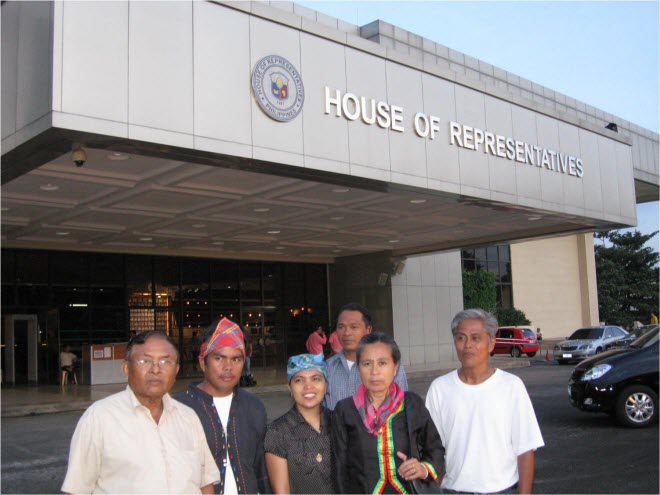
at the Batasan Pambansa
While the hearing in Mindanao continued, fifteen of the concerned were persuaded by their lawyer to go to Manila to file for a Writ of Kalikasan in the Supreme Court on 9 August seeking the cessation of mining operations in the Zamboanga Peninsula. The petitioners included a Muslim, a bishop, a lay person, local officials, Subanens and representative of different organizations: the Alliance to Save the Integrity of Nature (ASIN), DIOPIM – Dipolog, Ipil, Ozamiz, Pagadian, Iligan, Marawi – Committee on Mining Issue (DCMI), the KesalubuukanTupusumi Organization of Subanen People and Philippine Earth Justice Center Inc.
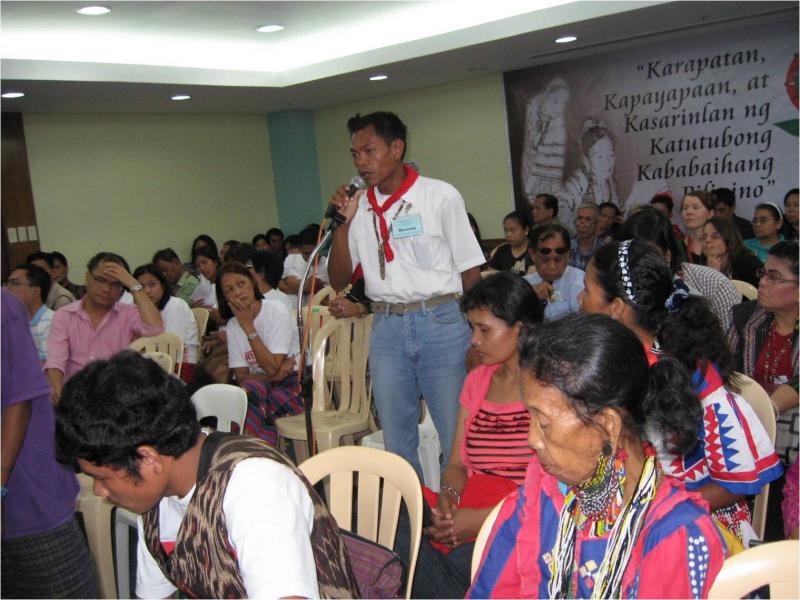
Participating World Indigenous Peoples Day Celebration
9 August is International Day of the World's Indigenous People. This year’s celebration is of great relevance to Philippine history. Representatives of Indigenous Peoples were invited to the Batasan Pambansa and granted, before the official proceedings, an hour and a half to be listened to. Six of the representatives from different parts of the country spoke and presented their concerns. It was noted that it was the first time in history of the Philippines that representatives of Indigenous Peoples were accommodated and entertained by Congress.

Filing petition for writ of kalikasan at the Supreme Court
And on 16 August, the Supreme Court partially granted the petition. It issued a writ of kalikasan directing the Department of Environment and Natural Resources (DENR) and the Mines and Geosciences Bureau (MGB) to stop issuing mining permits.
Sense of Hope
With the little resources that they have, the Subanens are able to survive with the help of the Columbans, the bishops, the Sisters, some lawyers, representatives in the house of Congress, and other support groups working for the cause of the Indigenous Peoples in our country. They would like to express their gratitude for the support given to them. Truly it is an avenue for many to convene and work for justice. The case continues, but this time the accused individuals are facing it with a sense of hope and gratitude.
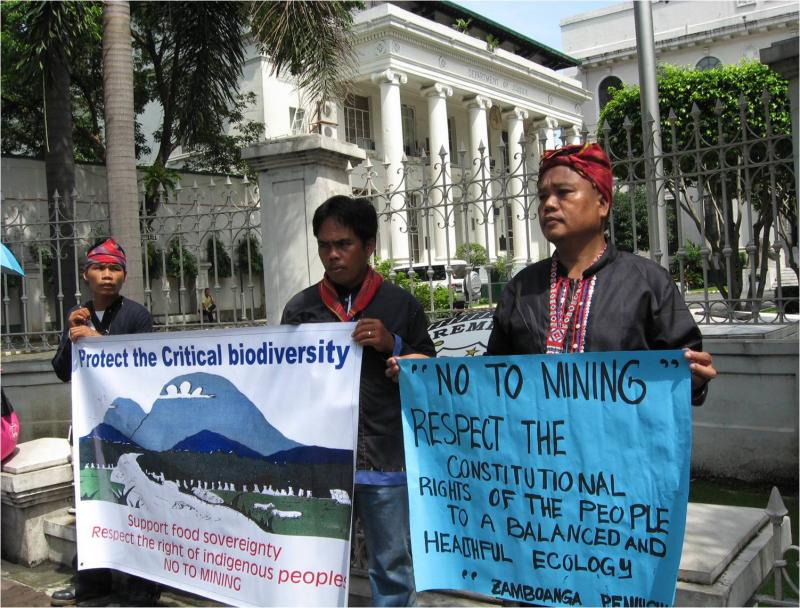
Surely the works of the Columbans as missionaries here in the Philippines is very challenging. Jesus spent time with the sick, the poor and the oppressed. Father Sean Martin, Sister Patty Adonaire and other Columbans chose to reach out to the Subanens in the same way, whatever it takes in the name of Mission. This is the way they found when they sought to follow Christ.
Yes, when it rains it pours, but with the peeping of the rainbow, a brighter day is sure to come. I am hoping for a peaceful Philippines. Having gone to Midsalip and seeing things for myself, I have this sense of hope that things will end in a fruitful and peaceful settlement.
= = = = = = = = = =
RELATED LINKS
- Pagmina o Kasiguroan sa Pagkaon ug Kaugmaon, a video on the struggles of the Subanen people against mining
- Mt. Pinukis an arena of debate on mining
- The Heart That Pumps Water
- Philippines: Mining or Food?
- RA 8371: Indigenous Peoples Rights Act
- RA 7942: Philippine Mining Act of 1995
Immigrant Spouses Journeying Towards Employment
By Necita A. Fetalvero
Necita or Cita, originally from Tubod, Lanao del Norte, Philippines, has a degree in Psychology. She joined the Columban Lay Mission orientation program in 2001. During her first and second mission terms in Korea she worked with the urban poor, based in a mission parish in Seoul. She facilitated liturgies and visited the elderly. She taught English to poor children and was also involved in Catholic scouting, which assists youth programs in the parish and in schools. After her sixth year as a Columban lay missionary she began to minister to multi-cultural families in Ganghwa Island. She writes about that here.
Cita is now home for good after nine years of mission work in Korea. She left the Columban Lay Missionaries to look after her aging and ailing parents. Her father was paralyzed by a stroke 20 years ago and his condition deteriorated last year. Her mother is suffering from diabetes and is scheduled for an eye operation soon.

Cita (far right) and Fr Laurence Kettle OFMCap with some Filipino women married to Koreans.
Reality
The presence of immigrant spouses in Korea, together with the even larger population of immigrant laborers, has challenged Korean society, homogeneous from time immemorial. With the recent rise in multi-cultural families, the government’s assistance program has helped foster acceptance of diversity and integrate multi-cultural families into mainstream society. According to the latest marriage statistics, one out of ten marriages is international. International marriages involve mainly two groups of men – those in rural areas who had never been married and divorced men of low socio-economic status in urban areas.
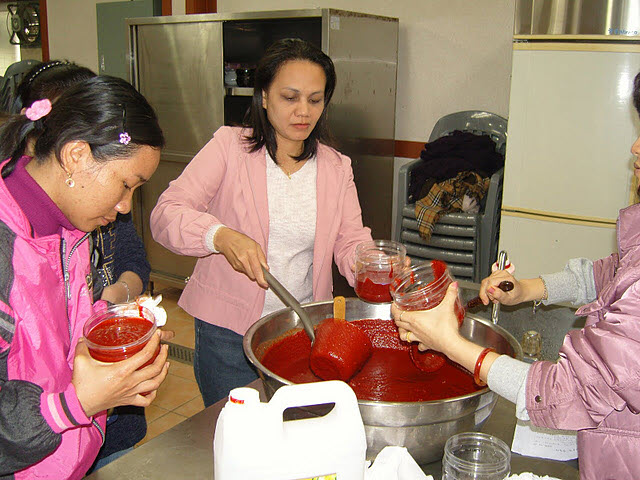
Cita during a demo on the preparation of Korean chili paste.
It is a reality that an increasing number of women are emigrating, whether for marriage or for better economic opportunities through work. Another contributing factor in the rapid increase of international marriages in Korea is the institutionalization of marriage brokers, both local and overseas. Brokers in Korea take Korean men to a pre-arranged overseas site where potential brides gather and it takes less than a week for the selection and simple wedding ceremony. Most of these women are from China and Southeast Asian countries. As the number of multi-cultural families increase, the level of problems faced by foreign wives and their children has also gone up. Most of these problems are related to the commercialization of broker-arranged marriages, domestic violence, conflicts with in-laws, discrimination against mixed-raced children, culture shock and language barriers.
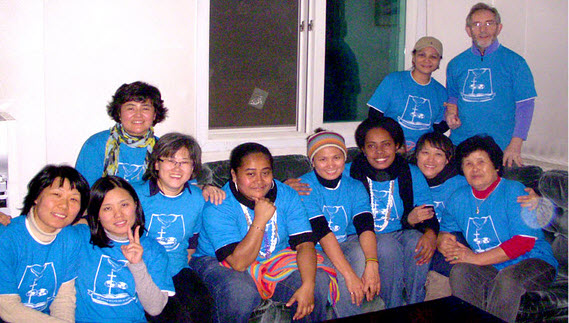
Cita and Columban Fr Seán Conneely (standing) with friends from different countries.
Response
The great need for ministry to women in international marriages and the multi-cultural dimension of Columban mission have led me to respond to this call and challenge in my mission. It is taking an active part in challenging society as it moves from being a one-ethnic group to being a multi-cultural one, a patriarchal society being challenged by the empowerment of the women of today. It was September 2009 when I started working at Ganghwa Gun Multi-cultural Family Center. Ganghwa is the fifth largest island in South Korea, in the estuary of the Han River on the west coast of South Korea, separated from the Korean mainland by a narrow channel, spanned by two bridges passable by public transport. North Korea is directly across the channel on the north coast of the island. There are about 65,000 inhabitants, mostly older people in the island, with about 300 multi-cultural families. They are engaged in farming and fishing. The Vietnamese form the largest number of foreign spouses, followed by Chinese and Filipinos. The rest are other South East Asian women.
Challenge
While I help at the center’s ongoing programs that facilitate adjustment to Korean culture, agricultural training and education, Korean cooking and language  classes, a child-rearing program, home visitation and other family activities, I have been deeply touched by the stories of the young women, accepting a whirlwind marriage and moving from their own cultures as they settle into an unfamiliar environment. Their stories of everyday lives, struggles, failures, learning, hopes and dreams as immigrant wives are very inspiring. Even if a language barriers and cultural differences often cause friction and conflict in their marriages, they make an effort to speak for themselves without fighting but by negotiation. Even if some families and husbands see these women as having been purchased for marriage, they prove themselves to be strong and they assert their cultural identity as immigrant wives with rights equal to those of Koreans.
classes, a child-rearing program, home visitation and other family activities, I have been deeply touched by the stories of the young women, accepting a whirlwind marriage and moving from their own cultures as they settle into an unfamiliar environment. Their stories of everyday lives, struggles, failures, learning, hopes and dreams as immigrant wives are very inspiring. Even if a language barriers and cultural differences often cause friction and conflict in their marriages, they make an effort to speak for themselves without fighting but by negotiation. Even if some families and husbands see these women as having been purchased for marriage, they prove themselves to be strong and they assert their cultural identity as immigrant wives with rights equal to those of Koreans.
Given the special task by the center of handling individual and group counseling for Filipino women in their native language, I have come to appreciate their vulnerability and strength in their journey. They need much more than counseling so I started a program in basic women’s orientation and leadership training, for they are potential leaders. As we share our lives together I meet them regularly for prayer and Bible sharing to deepen their faith. Their lives also deepen my faith. It is my hope and the goal of the center that what we have started with the Filipino women will also be organized for other immigrant women in the area.
My missionary life is enriched by my journey with women in their struggle for their integration into their Korean family, culture and society and in their journey towards empowering themselves. I serve as a little bridge for both cultures to walk on – Korean families and immigrant wives. I believe that mission in this particular ministry is not just prescribing change but rather journeying in the direction of balance in our churches, into our families and in our society – rediscovering the feminine side of God in an all-male image of God in the society.
You may email Cita at lucille1017@yahoo.com and find her on Facebook under the name ‘Necita A. Fetalvero’.
Night at the Riots
By Fr John Boles
Fr John Boles is from England and is currently Rector of Student Formation and Parish Priest of Santo Tomás Parish in Santiago, Chile. He belongs to the Columban Region of Peru.Fr Chris Saenz describes in this issue the 2011 riot in La Pintana. Here Fr Boles describes last year’s.
Ever think you might get tear-gassed? Here are a few survival tips: Have a wet handkerchief or surgical mask handy, to cover your nose and mouth; smear a little toothpaste under your eyes - it helps; don’t rub your eyes after being gassed, it’s better to let them stream; once you’ve reached safety, suck a lemon. Its recuperative qualities are remarkable.
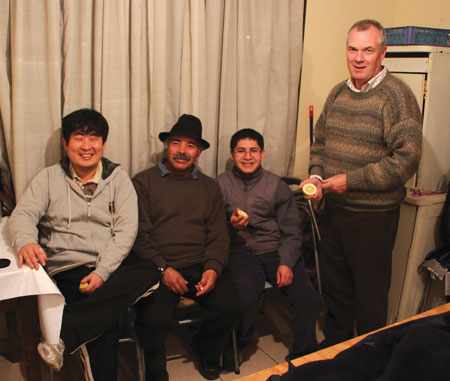
Fr John Boles with members of the "Parish Defence Force".
I never imagined that overseas mission might involve getting caught up in riots, but that was before I took up an appointment in a parish on the outskirts of Santiago, the capital of Chile. Santo Tomás parish is located in an area called La Pintana, and La Pintana has ‘history’.
In many ways, Chile is a vibrant, modern nation, probably the wealthiest and best-ordered in South America. It displays moments of great national solidarity - we witnessed the rescue of 33 miners from the now world-famous San José Mine in October 2010.
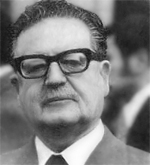 President Salvador Allende |
 General Augusto Pinochet |
Nevertheless, beneath the veneer of unity lie certain tensions, many of which stem from the military coup of 11 September 1973 when General Augusto Pinochet overthrew the parliamentary democracy headed by left-wing President Salvador Allende.
Nowadays, most of the world remembers 11 September – ‘9/11’ - as the date of the terrorist attacks on the Twin Towers in New York City. In Chile, however, it is still known as ‘The Day of the Coup’.
Since then, Chilean society has been divided between those who sympathized with Pinochet and those who opposed him. Even though democracy was restored in 1991, the anniversary of the coup is still marked by protests against the security forces. My area of La Pintana, a working-class stronghold, was a hotbed of resistance to military rule, and disturbances occur here every 11 September.
Our problem is that they tend to happen right in front of our parish centre and, at times, spill over into it!

Columban priest John Boles defends his church during September disturbances in Chile.
Hence, each 11 September the priest and parish council get kitted out and prepare to defend our church property. Opposite the entrance to the church lies a supermarket, often the target of looters. (Most of today’s protesters are youngsters who weren’t even born at the time of the coup. Many probably couldn’t even tell you what it was all about. They use the unrest as an excuse for vandalism and robbery).
The supermarket is always guarded by armed police, hunkered down behind concrete barricades. The rioters gather at nightfall, on the sports ground on the other side of the church. And so the action begins.
César, a parish stalwart, is a veteran of the event, with many years of guard duty on this night behind him. ‘It’s the same every year, just like a ritual’, he assured me . . . Apparently, the confrontation follows a well-established pattern. We have a grandstand view of proceedings standing on the roof of the parish hall, and sure enough, things began to work out just as César had predicted.
First, the electricity transformers were sabotaged, plunging the area into darkness. Next, roads were sealed off by erecting barriers of wood and tires, which were then set alight. Finally, the insurgents moved towards the fortified supermarket, throwing stones and bottles.
The police replied with tear gas shells. The rioters withdrew behind their lines - and both sides took a rest, before the whole process began again. And so it would continue, until late into the night.
The danger for us lies in the fact that, sometimes, the repulsed would-be looters have turned on the parish centre instead, venting their frustration on our property or looking to the church for easy pickings.
Once, they ransacked the parish office. Two years ago, they burnt down a wooden outbuilding. So, whenever they got too close for comfort, we don our masks and wet handkerchiefs and make a show of force around the perimeter of the parish centre. We take it in turns to dash for cover in a meeting-room, where we rest our eyes and suck our lemons before sallying forth once more.
Last year we got off lightly. The damage was limited to a few smashed windows and a badly scratched font-door. Maybe the general sense of national unity brought on by the February 2010 earthquake, and the plight of the trapped miners in the north of the country (not to be rescued for another month), had a moderating effect on the combatants. Or the wounds of a conflict going back decades are, with God’s help, finally healing.
In that case, maybe César won’t have to ‘man the barricades’ to defend his church for many more Septembers. Instead, he’ll be able to rest easy . . . and his parish priest as well.
You may email Father John at jboles53@hotmail.com
One Step Forward, Two Steps Back
By Fr G. Chris Saenz
Father Saenz, ordained in 2000, is from Omaha, Nebraska, USA, where the Columban headquarters in that country are located. He spent part of his formation period in the Philippines.
I’ve learned that mission is one step forward and two steps back. This insight hit me on the night of 11 September in our Columban Parish of Santo Tomás Apóstol in La Pintana, an area in the southern part of Santiago de Chile. At 2am I received a frantic call from our parish coordinator, Elizabeth, screaming and crying, ‘Father! They broke down the gates! They broke down the gates and now they are invading the parish!’ This is the story.

Columban priest John Boles defends his church during September disturbances in Chile.
11 September in Chile has a different meaning than in the United States. In Chile, the military dictatorship of Pinochet came to power on 11 September 1973. 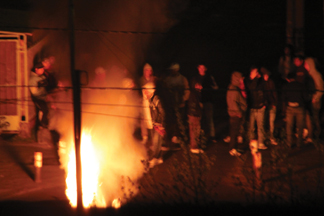 It is a date remembered with pain and anger. Every year 11 September invokes this memory that leads to riots and looting in certain areas of Chile, La Pintana, an inner city reality marked by poverty, violence and drugs, being one of the main hotbeds. Today many of the youth, who did not live during the military dictatorship, use 11 September to vent their feelings of impotence and deep anger against society. They often target institutional and public areas.
It is a date remembered with pain and anger. Every year 11 September invokes this memory that leads to riots and looting in certain areas of Chile, La Pintana, an inner city reality marked by poverty, violence and drugs, being one of the main hotbeds. Today many of the youth, who did not live during the military dictatorship, use 11 September to vent their feelings of impotence and deep anger against society. They often target institutional and public areas.
The main target in our parish is the Santa Isabel supermarket located next to our church. Each year the youth begin to gather around 9pm seeking to confront the police barricaded around the supermarket. They begin with by yelling profanities at the police. They blow up the transformers cutting power to the area, and burn piles of wood and rubber tires in the streets. Eventually, they rush the police barricades throwing stones. The police respond by firing tear gas. The mob grows to 200 or more, all trying to break into the supermarket.
This year the youth did not reach their target. The police repelled their attacks. Becoming more frustrated, the youth vented their anger on the parish.
Every year the parish asks for volunteers to guard the buildings. The received wisdom has been that if people are seen in the compound this will discourage possible looters from entering. This worked successfully in the past. The parish priest, Columban Fr John Boles, from Stockport, England, stayed in the main parish building, where the offices are, with Pedro Moon Byoung Jin, a Korean Columban lay missionary, and five other parish volunteers. Fr Michael Hoban, a Columban from New York City, and I kept guard in the parish house. As the outside assaults began to escalate we knew it would be a long night but never imagined the following events would occur.
As the night progressed I heard the shouting and the retaliatory firing of tear gas. At about one in the morning there was the sound of heavy pounding. I imagined that the youth were banging on the big metal gates of the parish which were locked. Even though my view of the gates was obscured by the main church, I was confident they would hold. Father John witnessed about 15 young men pushing and pounding on the gates for about an hour. Eventually, the gates began to give way. Suddenly about 50 more youths joined in. Father John described the scene as like ‘ants swarming in’. Our small group quickly locked the main parish building and ran for refuge to the fourth floor.
That is when I got the phone call. The mob tried to break the protective gates of the main parish building and threw rocks at the windows on the fourth floor. ‘They have remarkably good aim’, said an astonished Father John. We protected ourselves by shielding ourselves behind overturned tables. I called the police and informed them of the situation. They responded that they were doing what they could. I could hear shouting and breaking of materials. Eventually, I heard car alarms. The two cars in our compound were being broken into.
Father John and the parish volunteers informed me that once the mob realized that people were inside the main parish building they turned their attention to other unoccupied parish buildings. They broke down the doors and windows of our classrooms and kitchen and stole the refrigerator, oven, other kitchen supplies and hand tools. They took out and burned wooden benches. Some delinquents even tried to set fire to the kitchen. I maintained constant contact with our group by cell phone. After an hour the mob left. Father John and the volunteers quickly rushed out of the parish building and came to the parish house. I ran outside and was greeted with the sting of tear gas in the air. My eyes, throat and nose burned. I opened the house gates and let in our battle-weary group. Some were crying and all were bewildered. We locked ourselves in the parish house. Soon we heard pounding noises. The mob had returned for another round of looting. Eventually, all calmed down again around five in the morning when a police car arrived to assess the damage. We drove the volunteers to their homes and tried to get a little sleep so we could begin the next step of recovery.
What is the one step forward? Since the Columbans arrived in this parish seven years ago, we have worked hard to build up the community and improve the lives of the people. This past year we invested a lot of money in improving and repairing the parish facilities for the people. We had been robbed twice earlier this year. So we made great efforts to rebuild. The buildings were not only for parish activities such as catechesis but also for various social groups such as Alcoholics Anonymous, Child Daycare Facilities, Adolescent Pregnant Mothers, Children at Risk Learning Skills, Bakery Workshops, etc, all meant to give people new skills and hope to improve their lives. We were proud to have accomplished so much. The one step forward was our human efforts to build up the people.
What are the two steps back? Normally, we interpret these as set-backs. Definitely, what happened to us was a great set-back. However, I would like to think the two steps back as God’s grace revealing a truth that was overlooked. One can call it a ‘divine review’. The events of that night left me angry, frustrated and impotent to change anything. These emotions temporarily overclouded my view of the community. Our human efforts meant nothing. Yet God’s revelation came to me. It was pointed out that once the mob realized people were in the parish building they decided not to attack it. Also, they did not enter the main church, the parish house, the lay mission house or the center for the elderly on the property. No one was hurt.
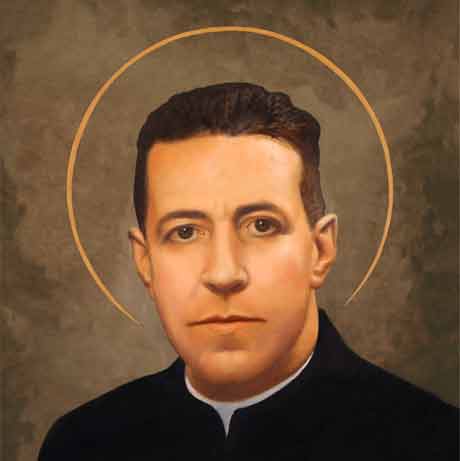 San Alberto Hurtado SJ |
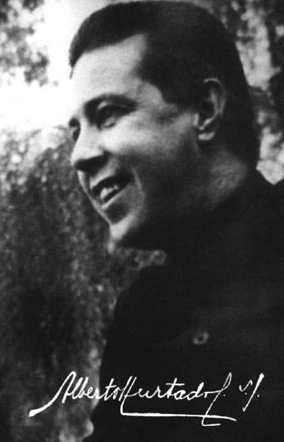 During the next few days, the community showed a sense of solidarity. One person immediately donated a refrigerator. Several donated their time to repair some of the damage. In our emergency parish council all our pastoral agents expressed their pain. They also expressed their sense of ‘we will not be defeated!’ We originally had planned a parish celebration on 16 September for Chilean Independence Day, El Dieciocho, ‘The 18th’. Some thought we should cancel it but nearly all expressed the desire ‘We must go on’.
During the next few days, the community showed a sense of solidarity. One person immediately donated a refrigerator. Several donated their time to repair some of the damage. In our emergency parish council all our pastoral agents expressed their pain. They also expressed their sense of ‘we will not be defeated!’ We originally had planned a parish celebration on 16 September for Chilean Independence Day, El Dieciocho, ‘The 18th’. Some thought we should cancel it but nearly all expressed the desire ‘We must go on’.
The parish celebration would be turned into a parish benefit to raise funds for repairs. Our sister chapel community, Padre Hurtado, named after Chile’s first saint, San Alberto Hurtado SJ (1901-1952), cancelled their own celebration to join ours. Other groups and communities expressed their desire to help out. In this ‘divine review’ God showed me that in spite of the harsh stark reality of La Pintana, the faith and courage of the people cannot be defeated. They continue the struggle to move forward. And that is God’s grace, the two steps back that allow us to take a step forward again with renewed faith.
You may email Father Chris at gchris.saenz@gmail.com
Our Hideaway
‘Blessed are the peacemakers for they will be called children of God’ (Matthew 5:9).
By Rose Jessica ‘Jet’ F. Octaviano

I feel special. I know in God’s eyes, we are all special. So I’ll say I feel extra special. I had the chance to witness my friends’ ordination to the priesthood. Priests are highly respected, seemingly one step higher than we are. They are our links to God. I am often overwhelmed even when with priests I know. Yes, I talk to them. I also confess my sins to them. I just never thought that I would have priests as good friends.
I am a peace advocate. My road to peace started during my college years at the University of St La Salle (USLS), Bacolod City. I was a community outreach volunteer. I had led a sheltered life and being a volunteer opened my eyes to the realities of life. We worked with street children and those in situations of armed conflict. I experienced living in one of the street children’s houses in the squatters’ area while my friends lived in nearby houses. This immersion made me a better person.
After graduation, I worked as a youth formator at Paghiliusa sa Paghidaet-Negros (Solidarity for Peace-Negros), a non-government organization dedicated to peace work. I continued the call for peace. I led in organizing our existing youth partners, the Young Ones for Peace (YuPeace), in different schools and communities in Negros Occidental. We used to come together regularly at the PEACETIVAL, held each September at the Capitol Lagoon, Bacolod City and the Negros Summer Youth Camps in April-May at Sitio Guintubdan in Bago City, both activities since discontinued due to lack of funds. But then I emigrated to the USA.
Ten years later, I came home to stay for awhile. I enrolled at the USLS Graduate School in the Masters of Arts in Conflict and Reconciliation Studies Program. Because of this I joined the Visayas Peacebuilding Institute (VPI) in held on 10-15 April 2010 at Balay Kalinungan, USLS. VPI is a collaborative effort between the Pax Christi Institute and the Institute for Negros Development of USLS. There were 32 participants from Luzon and the Visayas, NGO/GO workers, religious, discipline officers, church workers, teachers and other professionals.
I met Father Chris Militante and Father Kim Miro at the VPI. They were still seminarians then. They represented the Archdiocese of Palo, Leyte. We were curious about their lives. We asked them why they wanted to be priests, if they were really sure about it and when they would be ordained. They were patient with us. We all had fun.
We kept in touch through Facebook and texting. The Bacolod group met them again in September when they came to Bago City, just south of Bacolod City, for ongoing formation. We all had lunch together. I was also able to attend Mass with them along with about twenty other priests. It was a remarkable experience. I had never been in the company of so many priests. It is something I will always remember.
Finally on 24 May I received a text message from Father Kim giving me the date of their ordination! I felt elated and excited. It was also my task to tell the rest of the gang about this. I made plans to travel to Leyte for the ordination but was the only one from the Bacolod group who made it. My nephew Franz accompanied me. He and Father Kim became friends too.
Franz and I left Bacolod for Tacloban via Cebu on 18 June. We woke up late and almost missed our flight. It was our first time to visit Leyte and upon arrival in Tacloban we felt the warm hospitality of the people there. Father Kim and ‘Manong’ the driver brought us to our home for four days. It was a retreat house managed by the Franciscan Handmaids of the Lord, founded in Palo by Bishop Cipriano Urgel in 1979. It was peaceful place, conducive for reflection and I loved being there. Sister Virgie and the other Sisters were friendly and the girls who lived there were very helpful.
We visited the Archbishop’s Residence, Gonzaga House. We were very impressed. It was on top of a hill and was cool. From the balcony, you can see many trees. There were animals in the land and a tennis court. We were introduced to Father Gwen Padagdag who was to be ordained with Father Kim and Father Chris. Father Gwen was always smiling. The two invited me to attend the Family and Relatives’ Recollection next day.
At the recollection we met so many loving people, the families of the future priests, the Sisters and other priests. They were very welcoming and pleasant. We were shy at first and there was a communication problem. The people around us were either speaking in Waray or Cebuano. We were confused as we speak Hiligaynon (Ilonggo). But they were very cooperative – they spoke English or Tagalog to us. The recollection ended with the sacrament of penance. I felt purified and blessed.
Later, we attended the Rites of the Promise of Celibacy, Declaration of Free Choice and Profession of Faith followed by Holy Mass. I felt fortunate to witness the occasion. It was something extraordinary, a once in a lifetime event. A reception followed the Mass. Families and relatives were introduced. As the three, Fathers Chris, Kim and Gwen were batch mates, it was a chance for their families to get to know each other better too. We felt like members of their families too, except that we were the Ilonggo-speaking branch.
20 June finally arrived. We woke up early and were ready two hours before the ordination. It was a beautiful morning. As I witnessed the ordination, I had mixed feelings of joy and sadness. Mostly joy! I have friends who are now priests. I felt sad because I felt that things will not be the same for us. I still have this feeling that priests are above us, therefore, we are not on the same level anymore. It felt different somehow. I was awed by them.
I felt very blessed being able to attend the first Mass of Father Chris.
There was only one downside. I lost my camera. We were in downtown Tacloban City when my camera was taken from my knapsack. I was a bit careless. I had a good cry during Father Chris’s Mass and the ill feelings slowly vanished. I prayed for the thief. However, I would not exchange the trip for the camera. The camera can be replaced but never the experience.
Overall I can say two words about the notable experience: ‘Amazing Grace!’
Jet :)
ROSE JESSICA F. OCTAVIANO
Jet is the Chapter Executive Manager of the Philippine Mental Health Association (PMHA) Bacolod-Negros Occidental Chapter. PMHA is a non-government organization dedicated to the promotion of mental health and prevention of mental illness. You can email her at jet.octaviano@gmail.com.
Peace By Peace
St Columbanus Window of the crypt of the Abbey of Bobbio
Look after the peace of the church, stand between your sheep and the wolves.
~ St Columban ~God begins by restoring the humanity and dignity of the victim, a humanity and dignity which the wrong-doer tried to wrest away from the victim through violence. This restoration of humanity is at the very heart of the Christian understanding of reconciliation and I think we might add at the very heart of the struggle for human rights. That God would begin with the victim and not the wrong-doer is consistent with divine activity in history where God takes the side of the poor, the widowed and the orphan, the stranger and the imprisoned. Victims become the leaders of the movement towards reconciliation since they possess the vision that encompassed both the pain of the past and the promise of the future.
~ Fr Robert Schreiter, C.PP.S., Encounter - 15/08/99: Schreiter's Reconciliation Principle ~

Fr Robert Schreiter C.PP.S
Since we are travelers and pilgrims in the world, let us ever ponder on the end of the road, that is of our life, for the end of our roadway is our home (St Columban, 8th sermon).
Coastline of Bangor, Northern Ireland, where St Columban began his journey as a pilgrim for Christ c.589.
Bobbio, Italy, where St Columban died on 23 November 615, ending his journey as a pilgrim for Christ.
Whatever I had read as a child about the saints had thrilled me. I could see the nobility of giving one’s life for the sick, the maimed, the leper . . . But there was another question in my mind. Why was so much done in remedying the evil instead of avoiding it in the first place? . . . Where were the saints to try to change the social order, not just to minister to the slaves, but to do away with slavery?
~ Dorothy Day, Co-founder of the Catholic Worker (1897-1980) ~
Dorothy Day (1934)
One cries out, ‘Lord, how long?’ And then too what creeps into my mind is the little fear or big, that when it touches me personally, will I be faithful?
~ Sr Maura Clarke MM, Martyr of El Salvador
Sr Maura Clarke MM (1931-1980)
The Birth of Your Story
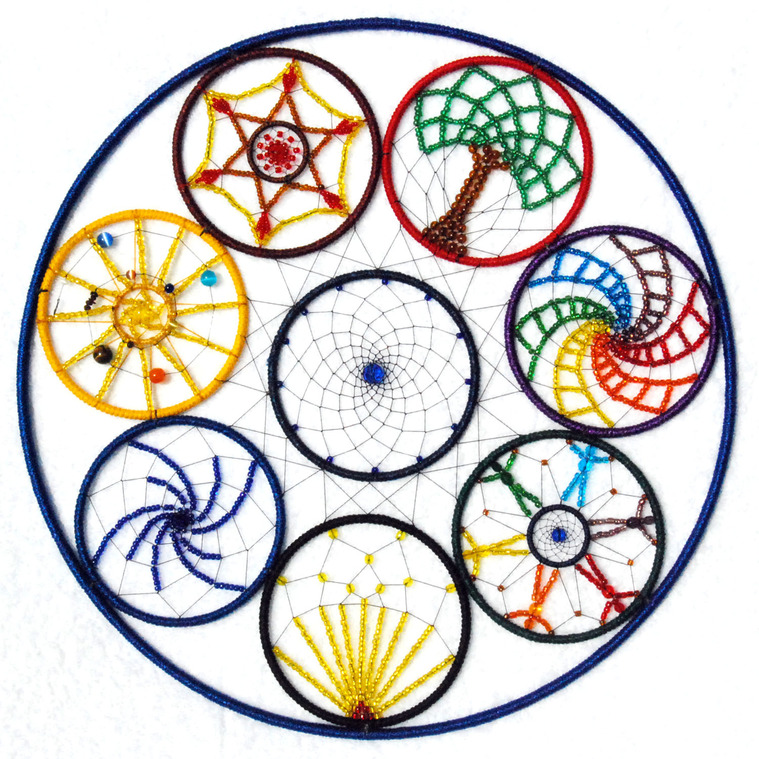
Then the Spirit said:
‘The habitats that grace the Earth
Were there to hold you at your birth,
And welcome you to the celebration
Of Creation’s transformation
From my fire that grew to be
A wondrous blue-green symphony.’
~ Fr Vincent Busch, The Creation Mandala ~
http://subanencrafts.com/creation_poem.html
Remembering Father Rufus
‘It’s all about living in harmony. That’s what we’re here for. And if there’s strife among people sooner or later they’ll have to sit down and talk. Better sooner than later’.
~ Fr Rufus Halley (1944-2001) ~
Providence and Google
By Fr Charles Duster

Fr Duster, from the USA, has worked in Japan and Fiji. During a visit to the Philippines in 1967 he and another Columban were to have traveled on a flight from Bacolod to Cebu on 6 July. Although slightly delayed because they had visited another Columban in hospital, they were still on time for checking in but they weren't allowed on board. The plane left early and crashed, all 21 on board being killed.
The ways of Providence are unusual and wonderful.
It started with a simple question over the dinner table at the Columban House on the north side of Chicago, ‘Rafa, what was your first contact with the Columban Fathers?’
Rafael (Rafa) Ramirez is a Columban seminarian from Chile who was completing a ten-month English language study program at De Paul University and returned to Chile in January 2010. He is continuing his theological studies at Catholic University, Santiago, in preparation for his first missionary assignment next year as a Columban missionary.
Rafa, age 32, was staying with us for two weeks while on pastoral experience working with the homeless at a food kitchen and shelter. His response was a fascinating story of amazing ‘coincidences’ which could fill a chapter of a book. Let me share with you the opening pages.

L to R: Rafael, John, Jorge, Gonzalo, Fr John Boles.
‘Six years ago, some companions and I were on a short holiday in Puerto Saavedra on the southern coast of Chile. One of our group, Angelica Soldado, had previously spent time with the Franciscan Sisters on the nearby island of Wapi where the Sisters worked with the indigenous Mapuche people. While there, she met two Columban lay missionaries from Fiji, Lusi Lutua and Monika Lewatikana who were also working with the Mapuche on the island.’
Rafa continued, ‘Angelica and I were strolling down the main street in Puerto Saavedra on our way to buy bread and some groceries for lunch when a bus came along heading for Wapi Island. Angelica spotted the Fijian girls riding in the bus and they spotted her. They started waving frantically at each other. At the next corner, the bus stopped and the two girls got off and ran toward us.
‘There were big hugs and kisses, Chilean style, and greetings like they were long lost sisters. I couldn’t get over the scene - those two tall Fijian girls so friendly, so warm, animated and enthusiastic getting off their bus to greet my friend. They even started all singing together some opening bars from a Fijian song they had taught Angelica earlier “Tulu tulu lu…” all this on the main street in the middle of Puerto Saavedra.

Monika Lewatikana
‘I was totally amazed and taken aback. The next moment the bus driver blew the horn and the two girls ran back and boarded the bus to continue back to the mission on the island. It was over in a few minutes, but what an encounter.
‘Afterwards, Angelica told me more about the two girls, how she had met them, something about their personalities, and how they happened to be living, working and obviously enjoying life as Columban lay missionaries so far from home. That was the first time I heard the name “Columban”’, Rafa concluded. ‘It stuck in my mind. When I got back to Temuco, I went on line and Googled it to find out more about these people.’
The rest, as they say, is history. Rafael spent several months finding out more about the Columbans, who first went to Chile in 1952. I was mesmerized by his account of how many ‘coincidences’ occurred which led him five years ago to join the Columban formation program for priesthood. I’m no expert but it seemed obvious to me that the Holy Spirit was involved.
Fiji, Southern Chile, Chicago, lots of miles between them but they all seemed to come together that evening at our dinner table.
We are Fiji
For six years I was the Coordinator of the Columban Lay Missionary Program in Fiji. During that time, Lusi and Monika were recruited, trained and missioned to Chile. I saw them off at Nadi Airport and was privileged to visit them in their mission in Wapi. Little did they dream that their just being themselves, being Fijian and getting off the bus, the most natural thing in the world for them to do, would be an instrument in a Chilean joining the Columbans.
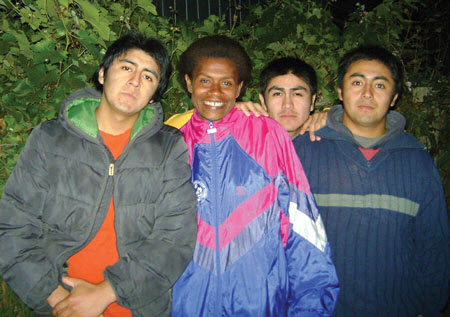
Monika Lewatikana with Chilean youth.
Can anyone doubt that the Lord is in control? Indeed, the rings formed by the pebble dropped in Fiji extended many miles.
Fr Charles Duster is currently working in Chicago, Il, USA. You may email him at cduster@columban.org
The Lord Of The Manger
Fr Vincent Busch
For the past ten years I have been working in a livelihood project with a group of Subanen artisans. Every year we design Christmas cards that simultaneously celebrate the story of God’s Creation and the story of God’s Incarnation. This year the Subanen artisans are carefully crafting images of Jesus in the manger within five ever-expanding settings from the tiny stable in Bethlehem to the vast heart of our spiraling Galaxy. While they craft cards, I have the task of crafting a reflection – with a lot of help from St Francis – about the meaning of their cards.
St Francis is credited with instituting the Christmas custom of setting up manger scenes in our homes and churches. The story goes that shortly before Christmas 1223 Francis encouraged the people of Greccio to reconstruct a manger scene in a cave near their town. He explained to the people: ‘If you want to celebrate the Feast of the Lord at Greccio, hurry and diligently prepare what I tell you. For I wish to recall to memory the little child who was born in Bethlehem. I want to set before our bodily eyes the hardship of his infant needs’. The manger scene touched the hearts of the people of Greccio and it continues to touch our hearts today.
Francis’ words make it clear that he never intended the manger scene to be a cute and cozy recollection of Christmas. Instead, he wanted to stress the ‘hardships’ facing Jesus.
The majority of Subanens live in conditions that resemble the hardships of that stable in Bethlehem. Traditionally, the Subanens lived off their habitat by gathering food and fuel from the forest and by small scale farming. Sadly for the Subanens, our global economy is quick to take their land. Timber, and minerals, but it has no time to care for the Subanens. In the name of rapid ‘progress’ loggers and miners have plundered and continue to plunder their land. Stripped of their fruitful habitat the Subanens are left impoverished.
The irony is that the impoverished Subanens and plundered habitat can only be saved by progress. Not the rapacious kind of ‘progress’ that eats the Earth but a wholesome progress that cares for life in its integrity. Again, St Francis can guide us. The Saint trusted totally in the Providential Love of God. He called it ‘Holy Poverty’. In modern social and ecological terms, ‘Holy Poverty’ is simply ‘Wholesome Living’. It means practicing life-styles and crafting economies that trust in God’s Love by living creatively and joyfully within the limits of God’s Creation. ‘Whole Living’ is what happens when people and societies ‘live simply so that people (like the Subanens) can simply live’. Only this kind of ‘Wholesome Living’ can guide our profit–oriented economies to value people and the Earth more than it values wealth.
When Blessed Pope John Paul II proclaimed St Francis the patron of ecology he praised Francis as, ‘an example of genuine and deep respect for the integrity of creation who invited all creation – animals, plants, and natural forces, even Brother Sun and Sister Moon – to give honor and praise to the Lord’. For Francis, the manger scene – with its images of Mary, Joseph, Jesus, shepherds, magi, animals, plants, sky and natural forces – was a miniature presentation of the entire Earth Community. Our wholesome participation in that Community creates a healthier home for all, and honors the Lord of Creation.
The Subanen artisans – Inday, Edith, Tata, Marissa, Juvy, Mercy, and Lisa – continue their card crafting. They are now meticulously inlaying images of a kneeling Mary as she places her new-born son in the manger of our blue-green Earth. I’ll end this reflection with a verse to honor their work.
On wood and straw he rests his head.
The Universe, his manger bed.
All Creation enfolds the birth
Of the Word made flesh on Earth.
Her open arms said, ‘Let it be’.
God’s Love now shares Earth’s destiny.
See the crafts and cards of the Subanens on their website: www.subanencrafts.com
‘PLANTED AND BUILT UP IN JESUS CHRIST, FIRM IN THE FAITH’ (cf Col 2:7)
By Sr Ashwena Apao SSC
Sister Ashwena is a Columban Sister from Jimenez, Misamis Occidental, which has one of the oldest Spanish churches in Mindanao and was a Columban parish for many years. She gets her name from the fact that she was born on Ash Wednesday. Sister Ashwena is based in Myitkyina, northern Myanmar.
This was the theme of World Youth Day (WYD) 2011, held recently in Madrid, Spain, in which 1.2 million persons participated. WYD was a time when young and not so young people from all over the world gathered together to pray and share experiences coming from within the cultural richness of each one. Everybody went with their own agenda, searching for truth, longing for a deeper meaning in their lives. Everybody wanted to encounter the truth of Jesus Christ, which they believed would set them free.
My journey to Spain was a great encounter of a loving, generous, and compassionate God whom I found in my daily ordinary meetings with the other participants. Those meetings made me realize how firm my faith in Jesus Christ is. WYD 2011 has been a journey of faith for me.
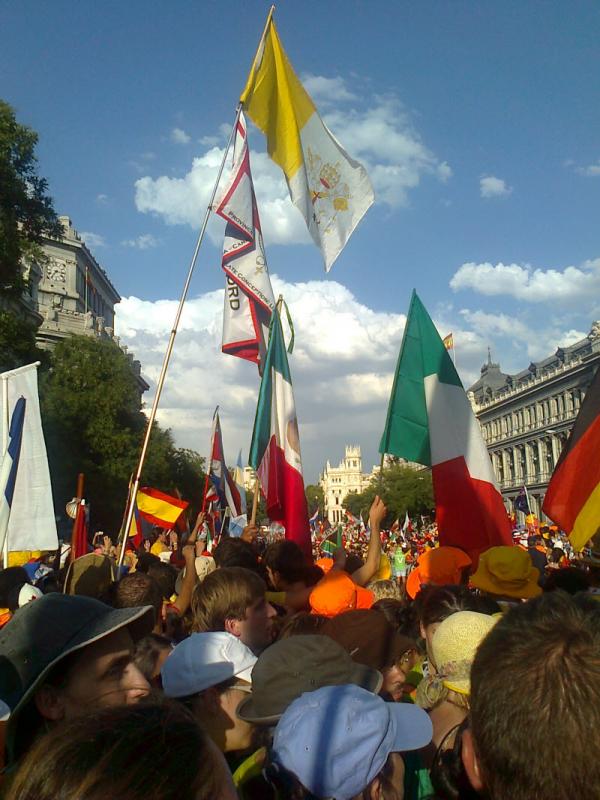
At the 1995 WYD in the Philippines, I was so touched by the words of Pope John Paul II encouraging young people to become missionaries, to become agents of love and peace to the whole world. That was the peak moment of my life, leading me to say ‘Yes’ to God’s call to me, to let go of my own personal desires and to share and proclaim God’s love to the whole world. Those moments of encounter have helped me in my missionary life especially during days of doubt, confusion, rejection, and the humiliations of being a missionary in a foreign country.
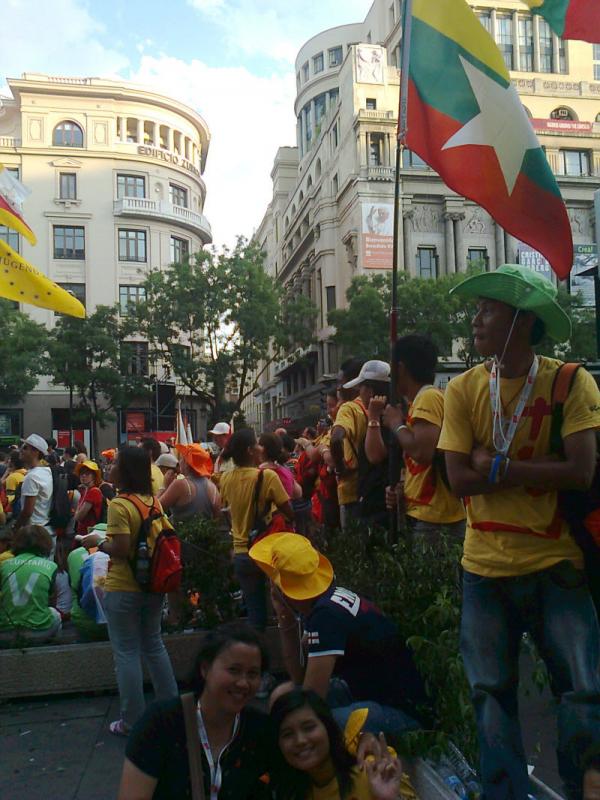
I am grateful to my congregation, the Columban Sisters, for giving me this opportunity to join WYD 2011, even though I don’t belong to the youth category anymore, strictly speaking! At the time the invitation came, I felt the need to rejuvenate the youthfulness in me in order to be a more effective agent of God’s love to others. I wanted to encounter again the God who called me and touched me during WYD 1995 in the presence of young people from all over the world.
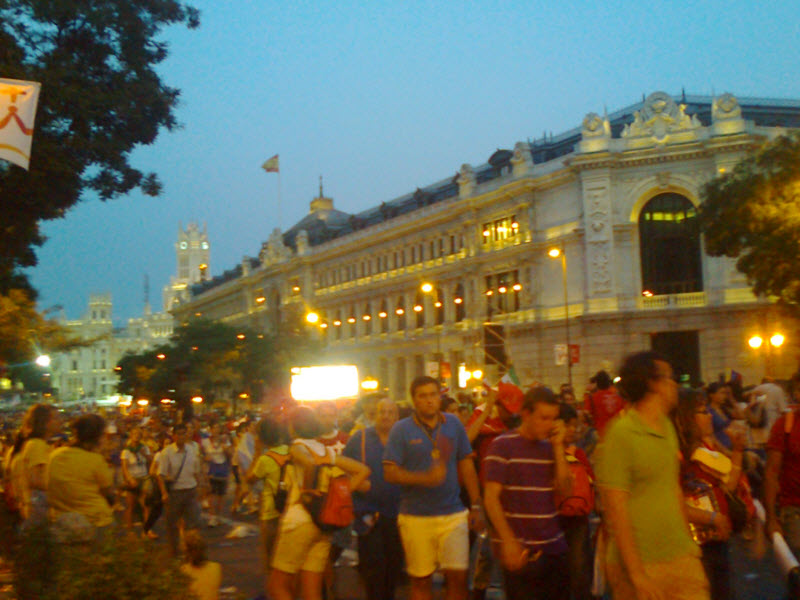
Now that I’m back from WYD 2011 I know that my prayers have been answered. The whole process involved, from my visa application to finding accommodation and a hosting family, to actual travel, to meeting generous people who helped me all the way to make my journey possible, was an experience of gifts sent by God to me. I believe God called me to be in Madrid for WYD 2011.
In WYD 2011, I found what I had been looking for. I met Jesus again on the journey. I strongly felt his question, ‘What are you looking for, Ashwena?’ He stayed with me, walked with me, and explained many things to me. Slowly I came to my senses again. I felt my heart was burning again to follow him and to be with him on the journey. I renewed my commitment again to be with people in a foreign land and be a witness there of his great love to all.
 |
WYD started with activities in different dioceses from 11 to 15 August. I went to the Diocese of San Sebastián in the Basque Country of northern Spain where St Ignatius of Loyola was born. I was the only Filipino and Myanmar participant there but I felt very welcome. The days in diocese focused more on prayer, and the sharing of one’s faith and culture. We prayed the international rosary, followed by Exposition of the Blessed Sacrament, with the presence of the relics of St Thérèse of Lisieux. Confessions went on at the same time. We had the culminating Mass at the Basilica of St Ignatius of Loyola built over the birthplace of the saint in Azpeitia. I was very happy to step on the holy ground of St Ignatius, his house and the chapel he prayed in, where his conversion took place.
 |
Plaza de Cibeles |
On 15 August all pilgrims travelled back to Madrid for the main event. I was very happy to find and join the Myanmar group there since I had been separated from them in the beginning. We were 26: 16 youths, nine priests and I.
I participated in the whole event with the group enthusiastically in spite of the scorching heat which reached up 40 Celsius. Millions gathered in the Plaza de Cibeles in the heart of Madrid. Antonio María Rouco Cardinal Varela, Archbishop of Madrid, was the main celebrant at the opening Mass on 16 August.
During the following days we were divided into language groups for the catechesis given by bishops from all over the world. In the afternoon, there were cultural gatherings, concerts, and some prayer sessions. In the afternoon of the 18th was the Papal welcome ceremony. There was great excitement and joy for everybody to meet the Pope even from a distance.
Welcoming Pope Benedict at Plaza de Cibeles
On the afternoon of the 19th was the Via Crucis, the Way of the Cross, where statues from traditional Spanish Holy Week celebrations were used. It was very moving because everybody was reminded of the suffering of Jesus for truth and love.
Statues used in the Via Crucis
On the night of the 20th in Aeródromo Cuatro Vientos (‘Four Winds Airport’) all the participants, volunteers, and guests came together with the Pope too for the all-night vigil that included Adoration of the Blessed Sacrament. The whole crowd spent the night in the open field for the culmination of WYD, the Eucharistic Celebration at 9:30, the morning of Sunday 21 August.
All-Night Vigil at Cuatro Vientos
The Pope concelebrated the Mass with thousands of bishops, and priests. There were many religious sisters, priests, brothers and secular groups present also. Pope Benedict encouraged everybody, especially young people, to go out to the whole world and become witnesses to their faith. The Pope urged and encouraged them to follow and answer God generously and bravely; to communicate the joy of their faith in Christ to others and not to keep it within because the world needs the testimony of each one’s faith.
The Pope also reminded the young people of the need to follow Christ within the Church, receiving the sacraments; ‘For your friendship with Christ to grow, it is fundamental to recognize the importance of your joyful insertion in the parishes, communities, movements as well as participation in the Eucharist every Sunday; the frequent reception of the sacrament of forgiveness and the cultivation of prayer and meditation on the Word of God’. He thanked the young people because they rejuvenate him, inspire the Church and refresh the world thirsty for hope and courage. The Pope sent out the young people as ambassadors of the joy that our world needs. He announced that WYD 2013 will be held in Rio de Janeiro, Brazil.
Closing Mass and ceremonies
The whole event went well. Indeed, it wasn’t considered an event so much as a time of evangelization and conversion. The experiences will continue to stir the hearts of all pilgrims who encounter the truth and love of Jesus. I am one of them. I am very much alive and awake as I go back to my mission assignment to share the love of God especially with young people.
As a final word, I encourage you to join World Youth Day. It is worth going to because it is a journey of faith in and with Jesus Christ, the Source of all our being.
You may email Sister Ashwena at apaoashwena@gmail.com and find her at Facebook under the name ‘Ashwena Apao’.
Some Addresses and Homilies of Pope Benedict at WYD 2011
- Welcome Ceremony with Young People, Plaza de Cibeles, Madrid Thursday, 18 August 2011, Address.
- Meeting with Young Women Religious, Monastery of San Lorenzo de El Escorial, Friday, 19 August 2011, Address.
- Meeting with Young University Professors, Basilica of the Monastery of San Lorenzo de El Escorial, Friday, 19 August 2011, Address.
- The Way of the Cross, Plaza de Cibeles, Friday, 19 August 2011, Address.
- Holy Mass with Seminarians, Cathedral of Santa María la Real de la Almudena, Saturday 20 August 2011, Homily.
- Visit to Young Persons with Disabilities, Fundación Instituto S. José, Saturday 20 August 2011, Address.
- Prayer Vigil at Cuatro Vientos Airport, Saturday 20 August 201, Homily.
- Holy Mass on the Occasion of the 26th World Youth Day, Cuatro Vientos Airport, 21 August 2011, Homily.


